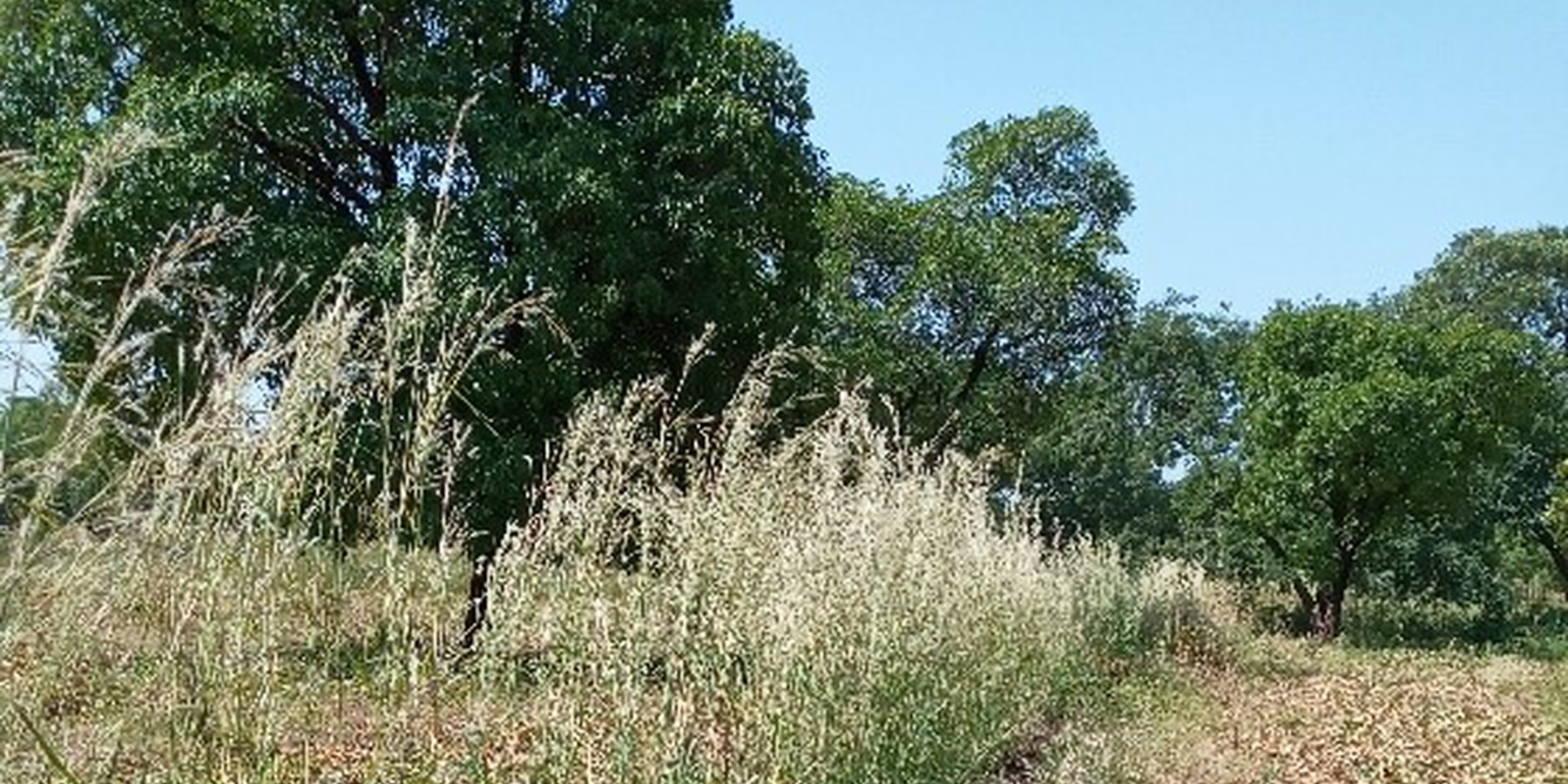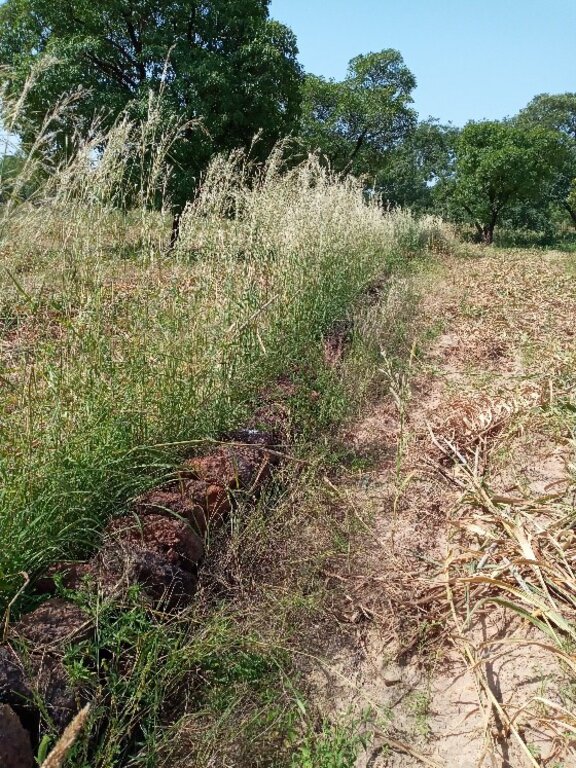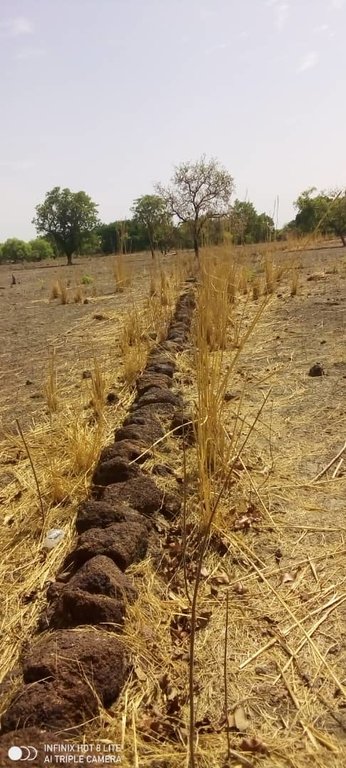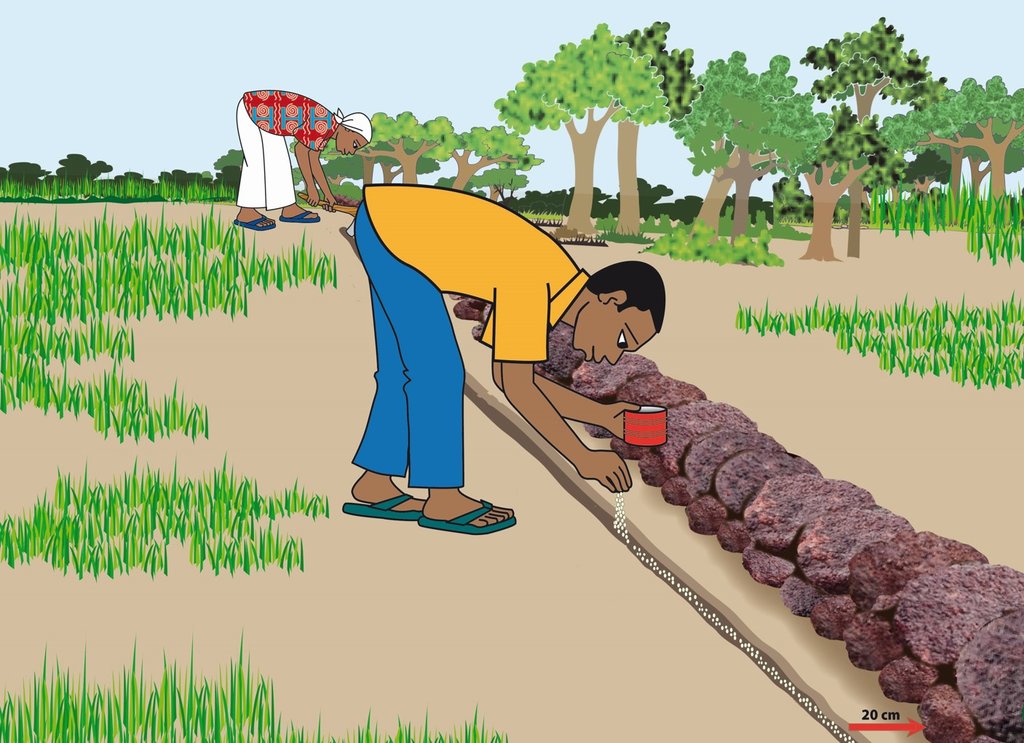Vegetation of contour stone bunds using herbaceous species [Burkina Faso]
- Creation:
- Update:
- Compiler: Moussa ABOU
- Editors: Brice Sosthène BAYALA, Siagbé Golli, Tabitha Nekesa, Ahmadou Gaye
- Reviewers: Sally Bunning, Rima Mekdaschi Studer, William Critchley
technologies_6729 - Burkina Faso
View sections
Expand all Collapse all1. General information
1.2 Contact details of resource persons and institutions involved in the assessment and documentation of the Technology
Key resource person(s)
land user:
DOYE Minbissi
Burkina Faso
land user:
DOYE D. Vincent
Burkina Faso
Name of project which facilitated the documentation/ evaluation of the Technology (if relevant)
Soil protection and rehabilitation for food security (ProSo(i)l)Name of the institution(s) which facilitated the documentation/ evaluation of the Technology (if relevant)
Deutsche Gesellschaft für Internationale Zusammenarbeit (GIZ)1.3 Conditions regarding the use of data documented through WOCAT
The compiler and key resource person(s) accept the conditions regarding the use of data documented through WOCAT:
Yes
1.4 Declaration on sustainability of the described Technology
Is the Technology described here problematic with regard to land degradation, so that it cannot be declared a sustainable land management technology?
No
2. Description of the SLM Technology
2.1 Short description of the Technology
Definition of the Technology:
Vegetation along contour stone bunds with herbaceous species adds an additional water and soil conservation measure on sloping agricultural lands.
2.2 Detailed description of the Technology
Description:
This case study focuses on the revegetation of stone bunds with herbaceous plants such as Andropogon sp., which is a species suited to the agro-ecological conditions of the Hauts-Bassins region. This technology can be applied across different agro-ecological zones.
Vegetating contour stone bunds with Andropogon sp. creates biological barriers that enhance the role of stone bunds in controlling runoff and soil erosion, with the added benefit of producing fodder for farmers. The strip may include other annual or perennial species that help maintain the filtering system of the stone barriers, fix and stabilize the structures and produce biomass for various uses (domestic use, fodder, etc.).
The main activities involved are as follows:
•Stage 1: Selection of the grass
The grass must have a root system strong enough to survive during the dry season. It must also grow easily and quickly. It must not interfere with field crops. This documentation focuses on revegetation with Andropogon gayanus, which is drought and bushfire resistant.
•Stage 2
Harvest or buy seeds prepare the Andropogon seedlings
Mix the seeds with moist sand for 12 to 24 hours;
Stir the mixture to remove the seed hairs;
Let the mixture rest in a bag to allow the water to penetrate the seeds. The seeds germinate 5 to 8 days later.
•Stage 3: Trenching
This stage involves digging a trench at least 30 cm deep along and upstream of the stone bunds.
•Stage 4: Sowing
Sowing takes place at the beginning of the rainy season when the soil is being prepared for cultivation. Seeds are sown in the trench about 20 cm upstream of the stone cordon. The sowing rate varies from 4 to 5 kg/ha.
The main inputs required to implement this technology are as follows:
–Andropogon gayanus seeds;
– “A-Frame” or watertube level;
– Sand
– Tools (pickaxe, shovel, cart, wheelbarrow, etc.).
The advantages of this technology are:
–Improved soil fertility through the capture and sedimentation upstream of the bunds;
–Conservation of the filtering system of the stone strips;
–Reduced soil degradation, erosion and runoff;
–Improved water infiltration;
–Maintenance of the soil's productive potential;
–Improved availability of fodder;
–Diversified income for farmers.
This technology produces green fodder, if cut when the crop is at an early growth stage, and hay (when it is mature and has lost its nutritional value) which is used to make secco, mats, etc. The farmers claim that it improves their income through the sale of grasses, secco and mats.
2.3 Photos of the Technology
2.5 Country/ region/ locations where the Technology has been applied and which are covered by this assessment
Country:
Burkina Faso
Region/ State/ Province:
Hauts-Bassins Region, Tuy Province
Further specification of location:
Dimikuy (Commune of Béréba)
Specify the spread of the Technology:
- applied at specific points/ concentrated on a small area
Is/are the technology site(s) located in a permanently protected area?
No
2.6 Date of implementation
Indicate year of implementation:
2017
2.7 Introduction of the Technology
Specify how the Technology was introduced:
- through projects/ external interventions
Comments (type of project, etc.):
The vegetation of stone bunds is a technology promoted by ProSoil.
3. Classification of the SLM Technology
3.1 Main purpose(s) of the Technology
- improve production
- reduce, prevent, restore land degradation
- protect a watershed/ downstream areas – in combination with other Technologies
- create beneficial economic impact
3.2 Current land use type(s) where the Technology is applied
Land use mixed within the same land unit:
Yes
Specify mixed land use (crops/ grazing/ trees):
- Agroforestry

Cropland
- Annual cropping
- Tree and shrub cropping
Annual cropping - Specify crops:
- cereals - maize
- cereals - millet
- fibre crops - cotton
Tree and shrub cropping - Specify crops:
- karite (sheanut)
- Grape tree, African locust bean (Néré) tree
Number of growing seasons per year:
- 1
Is intercropping practiced?
No
Is crop rotation practiced?
Yes
If yes, specify:
Cotton, maize, millet
3.3 Has land use changed due to the implementation of the Technology?
Has land use changed due to the implementation of the Technology?
- No (Continue with question 3.4)
3.4 Water supply
Water supply for the land on which the Technology is applied:
- rainfed
3.5 SLM group to which the Technology belongs
- improved ground/ vegetation cover
- cross-slope measure
3.6 SLM measures comprising the Technology

vegetative measures
- V2: Grasses and perennial herbaceous plants

structural measures
- S2: Bunds, banks
3.7 Main types of land degradation addressed by the Technology

soil erosion by water
- Wt: loss of topsoil/ surface erosion
- Wg: gully erosion/ gullying
- Wo: offsite degradation effects

soil erosion by wind
- Et: loss of topsoil
- Eo: offsite degradation effects
3.8 Prevention, reduction, or restoration of land degradation
Specify the goal of the Technology with regard to land degradation:
- reduce land degradation
4. Technical specifications, implementation activities, inputs, and costs
4.1 Technical drawing of the Technology
Technical specifications (related to technical drawing):
Trench at least 30 cm deep along the structures;
Direct seeding upstream and along stone structures at about 20 cm from them in the trench;
Andropogon sp seeds;
Seeding rate ranging from 4 to 5 kg/ha or a 200 ml line;
Stone structures;
Installation of the grass cover at the beginning of the rainy season
Author:
ProSoil
Date:
2021
4.2 General information regarding the calculation of inputs and costs
Specify how costs and inputs were calculated:
- per Technology unit
Specify unit:
Linear meter
If relevant, indicate exchange rate from USD to local currency (e.g. 1 USD = 79.9 Brazilian Real): 1 USD =:
613.5
Indicate average wage cost of hired labour per day:
CFA F 2,000
4.3 Establishment activities
| Activity | Timing (season) | |
|---|---|---|
| 1. | Installation/excavation of the anchoring trench | Beginning of the rainy season |
| 2. | Purchase of seeds | Beginning of the rainy season |
| 3. | Acquisition of small equipment | Beginning of the rainy season |
| 4. | Seeding | Beginning of the rainy season |
| 5. | Monitoring of activities | Rainy season/Dry season |
| 6. | Coordination of activities | Rainy season/Dry season |
4.4 Costs and inputs needed for establishment
| Specify input | Unit | Quantity | Costs per Unit | Total costs per input | % of costs borne by land users | |
|---|---|---|---|---|---|---|
| Labour | Installation/excavation of the anchoring trench | Linear meter | 1.0 | 5.0 | 5.0 | |
| Labour | Seeding | Linear meter | 1.0 | 15.0 | 15.0 | |
| Equipment | Acquisition of small equipment | Linear meter | 1.0 | 5.0 | 5.0 | |
| Plant material | Seeds | Kg | 1.0 | 666.67 | 666.67 | |
| Other | Monitoring costs | Linear meter | 1.0 | 10.0 | 10.0 | |
| Other | Coordination costs | Linear meter | 1.0 | 5.0 | 5.0 | |
| Total costs for establishment of the Technology | 706.67 | |||||
| Total costs for establishment of the Technology in USD | 1.15 | |||||
If land user bore less than 100% of costs, indicate who covered the remaining costs:
ProSoil promotes this technology and finances its implementation.
Comments:
Monitoring and coordination fall within the remit of agricultural technicians. To this end, they monitor and coordinate the activities of the working groups set up to implement this technology.
4.5 Maintenance/ recurrent activities
| Activity | Timing/ frequency | |
|---|---|---|
| 1. | Maintenance and repair of stone barriers and protection against roaming animals | At the beginning of the crop season. |
Comments:
Maintenance activities are minimal, primarily consisting of precautionary measures. This entails waiting until the fields have been ploughed and treated with herbicides before sowing Andropogon gayanus seeds. This also involves raising awareness and engaging all the farmers concerned in the process of implementing this technology.
4.6 Costs and inputs needed for maintenance/ recurrent activities (per year)
| Specify input | Unit | Quantity | Costs per Unit | Total costs per input | % of costs borne by land users | |
|---|---|---|---|---|---|---|
| Other | Maintenance and repair of stone barriers and protection against roaming animals | Linear meter | 1.0 | 10.0 | 10.0 | 100.0 |
| Total costs for maintenance of the Technology | 10.0 | |||||
| Total costs for maintenance of the Technology in USD | 0.02 | |||||
Comments:
Not applicable
4.7 Most important factors affecting the costs
Describe the most determinate factors affecting the costs:
The most significant factor affecting costs is seed and labour availability.
5. Natural and human environment
5.1 Climate
Annual rainfall
- < 250 mm
- 251-500 mm
- 501-750 mm
- 751-1,000 mm
- 1,001-1,500 mm
- 1,501-2,000 mm
- 2,001-3,000 mm
- 3,001-4,000 mm
- > 4,000 mm
Specify average annual rainfall (if known), in mm:
900.00
Specifications/ comments on rainfall:
The Hauts Bassins region, where the commune de Koumbia is located, experiences a North Sudanese and South Sudanese tropical climate. This climate is characterized by two (02) main seasons: a wet season lasting 06 to 07 months (May to October/November) and a dry season lasting 05 to 06 months (November/December to April). Annual rainfall is relatively abundant, ranging from 800 to 1,200 mm.
Indicate the name of the reference meteorological station considered:
Houndé Rainfall Station
Agro-climatic zone
- sub-humid
Average temperatures vary between 24°c and 30°c, with a relatively small temperature range of 5°c.
5.2 Topography
Slopes on average:
- flat (0-2%)
- gentle (3-5%)
- moderate (6-10%)
- rolling (11-15%)
- hilly (16-30%)
- steep (31-60%)
- very steep (>60%)
Landforms:
- plateau/plains
- ridges
- mountain slopes
- hill slopes
- footslopes
- valley floors
Altitudinal zone:
- 0-100 m a.s.l.
- 101-500 m a.s.l.
- 501-1,000 m a.s.l.
- 1,001-1,500 m a.s.l.
- 1,501-2,000 m a.s.l.
- 2,001-2,500 m a.s.l.
- 2,501-3,000 m a.s.l.
- 3,001-4,000 m a.s.l.
- > 4,000 m a.s.l.
Indicate if the Technology is specifically applied in:
- convex situations
5.3 Soils
Soil depth on average:
- very shallow (0-20 cm)
- shallow (21-50 cm)
- moderately deep (51-80 cm)
- deep (81-120 cm)
- very deep (> 120 cm)
Soil texture (topsoil):
- coarse/ light (sandy)
- fine/ heavy (clay)
Soil texture (> 20 cm below surface):
- coarse/ light (sandy)
- fine/ heavy (clay)
Topsoil organic matter:
- medium (1-3%)
If available, attach full soil description or specify the available information, e.g. soil type, soil PH/ acidity, Cation Exchange Capacity, nitrogen, salinity etc.
The soils are predominantly leached tropical ferruginous soils with varying degrees of sandiness in the uplands and clay soils with differing levels of hydromorphy (waterlogging) in the lowlands.
5.4 Water availability and quality
Ground water table:
5-50 m
Availability of surface water:
good
Water quality (untreated):
poor drinking water (treatment required)
Water quality refers to:
both ground and surface water
Is water salinity a problem?
No
Is flooding of the area occurring?
No
5.5 Biodiversity
Species diversity:
- medium
Habitat diversity:
- medium
5.6 Characteristics of land users applying the Technology
Sedentary or nomadic:
- Sedentary
Market orientation of production system:
- mixed (subsistence/ commercial)
Off-farm income:
- less than 10% of all income
Relative level of wealth:
- average
Individuals or groups:
- individual/ household
Level of mechanization:
- animal traction
Gender:
- men
Age of land users:
- middle-aged
5.7 Average area of land used by land users applying the Technology
- < 0.5 ha
- 0.5-1 ha
- 1-2 ha
- 2-5 ha
- 5-15 ha
- 15-50 ha
- 50-100 ha
- 100-500 ha
- 500-1,000 ha
- 1,000-10,000 ha
- > 10,000 ha
Is this considered small-, medium- or large-scale (referring to local context)?
- medium-scale
5.8 Land ownership, land use rights, and water use rights
Land ownership:
- individual, not titled
Land use rights:
- open access (unorganized)
Water use rights:
- open access (unorganized)
Are land use rights based on a traditional legal system?
Yes
Specify:
Due to the sacred nature of the land, custom dictates that its management must not be subject to speculation
Comments:
Based on information gathered from both literature and interviews, land access in the village of Dimikuy is mainly through inheritance and lending. Other modes of access (lending, leasing and buying) do not appear to be common, nor perceptible.
5.9 Access to services and infrastructure
health:
- poor
- moderate
- good
education:
- poor
- moderate
- good
technical assistance:
- poor
- moderate
- good
employment (e.g. off-farm):
- poor
- moderate
- good
markets:
- poor
- moderate
- good
energy:
- poor
- moderate
- good
roads and transport:
- poor
- moderate
- good
drinking water and sanitation:
- poor
- moderate
- good
financial services:
- poor
- moderate
- good
6. Impacts and concluding statements
6.1 On-site impacts the Technology has shown
Socio-economic impacts
Production
crop production
crop quality
fodder production
fodder quality
Income and costs
expenses on agricultural inputs
farm income
diversity of income sources
Socio-cultural impacts
food security/ self-sufficiency
recreational opportunities
SLM/ land degradation knowledge
Ecological impacts
Water cycle/ runoff
surface runoff
Soil
soil moisture
soil cover
soil loss
Biodiversity: vegetation, animals
biomass/ above ground C
Climate and disaster risk reduction
flood impacts
wind velocity
6.2 Off-site impacts the Technology has shown
buffering/ filtering capacity
6.3 Exposure and sensitivity of the Technology to gradual climate change and climate-related extremes/ disasters (as perceived by land users)
Gradual climate change
Gradual climate change
| Season | increase or decrease | How does the Technology cope with it? | |
|---|---|---|---|
| annual temperature | increase | moderately | |
| annual rainfall | decrease | moderately |
Climate-related extremes (disasters)
Meteorological disasters
| How does the Technology cope with it? | |
|---|---|
| local thunderstorm | moderately |
6.4 Cost-benefit analysis
How do the benefits compare with the establishment costs (from land users’ perspective)?
Short-term returns:
slightly positive
Long-term returns:
very positive
How do the benefits compare with the maintenance/ recurrent costs (from land users' perspective)?
Short-term returns:
slightly positive
Long-term returns:
very positive
6.5 Adoption of the Technology
- 1-10%
Of all those who have adopted the Technology, how many did so spontaneously, i.e. without receiving any material incentives/ payments?
- 0-10%
6.6 Adaptation
Has the Technology been modified recently to adapt to changing conditions?
No
6.7 Strengths/ advantages/ opportunities of the Technology
| Strengths/ advantages/ opportunities in the land user’s view |
|---|
| Reduced soil degradation, erosion and runoff. |
| Improves water infiltration |
| Maintains the soil's productive potential. |
| Generates additional income through the sale of straw mats and seccos and the sale of straw. |
| Strengths/ advantages/ opportunities in the compiler’s or other key resource person’s view |
|---|
| Improves soil fertility. |
| Preservation of the filtering system of water and soil conservation structures. |
6.8 Weaknesses/ disadvantages/ risks of the Technology and ways of overcoming them
| Weaknesses/ disadvantages/ risks in the land user’s view | How can they be overcome? |
|---|---|
| Requires equipment for seedling installation and maintenance. | Continued supply of equipment to producers. |
| Weaknesses/ disadvantages/ risks in the compiler’s or other key resource person’s view | How can they be overcome? |
|---|---|
| Effects not immediately perceptible in the first few years of installation. | Maintenance of seedlings. |
| Requires a minimum of technical skill to install. | Building farmers' capacity to implement the technology. |
7. References and links
7.1 Methods/ sources of information
- field visits, field surveys
2
- interviews with land users
2
- interviews with SLM specialists/ experts
1
- compilation from reports and other existing documentation
7
When were the data compiled (in the field)?
01/22/2023
7.2 References to available publications
Title, author, year, ISBN:
Recueil des pratiques agro-écologiques éprouvées et mises en œuvre au Burkina Faso, Centre National de la Recherche Scientifique et Technologique, 2020/Compendium of proven agro-ecological practices implemented in Burkina Faso, National Scientific and Technological Research Center, 2020
Available from where? Costs?
Available on the Internet
Title, author, year, ISBN:
Catalogue de fiches techniques des mesures d’amélioration de la fertilité des sols, Projet « Réhabilitation et protection des sols dégradés et renforcement des instances foncières locales dans les zones rurales du Burkina Faso » (ProSol), 2020/A catalog of data sheets on soil fertility improvement measures, under the project entitled "Rehabilitation and protection of degraded soils and strengthening of local land tenure bodies in the rural areas of Burkina Faso" (ProSol), 2020
Available from where? Costs?
Available at ProSol-Burkina Faso
Title, author, year, ISBN:
Catalogue des mesures CES/DRS promues par le ProSol, 2020/A catalog of WSC/SDR measures promoted by ProSol, 2020
Available from where? Costs?
Available at ProSol-Burkina Faso
Title, author, year, ISBN:
Diagnostic sur les sites d’extension de quatre (04) micros bassins versants au profit du ProSol, Projet « Réhabilitation et protection des sols dégradés et renforcement des instances foncières locales dans les zones rurales du Burkina Faso » (ProSol), 2020/A diagnostic assessment of the extension sites of four (04) micro-catchment areas for the ProSol project, "Rehabilitation and protection of degraded soils and strengthening of local land tenure bodies in the rural areas of Burkina Faso" (ProSol), 2020
Available from where? Costs?
Available at ProSol-Burkina Faso
Title, author, year, ISBN:
Étude sur l’analyse coûts-bénéfices et économiques des mesures CES/DRS promues par ProSol, Projet « Réhabilitation et protection des sols dégradés et renforcement des instances foncières locales dans les zones rurales du Burkina Faso » (ProSol), 2020/A study on the cost-benefit and economic analysis of the WSC/SDR measures promoted by ProSol, under the project entitled "Rehabilitation and protection of degraded soils and strengthening of local land tenure bodies in the rural areas of Burkina Faso" (ProSol), 2020
Available from where? Costs?
Available at ProSol-Burkina Faso
Title, author, year, ISBN:
Réalisation d’un diagnostic de l’état des ressources naturelles et de la gestion foncière dans les régions du Sud-Ouest et des Hauts-Bassins au Burkina Faso, Projet « Réhabilitation et protection des sols dégradés et renforcement des instances foncières locales dans les zones rurales du Burkina Faso » (ProSol), 2015/A diagnostic study of the state of natural resources and land tenure management in the South-West and Hauts-Bassins regions of Burkina Faso, under the project entitled "Rehabilitation and protection of degraded soils and strengthening of local land tenure bodies in the rural areas of Burkina Faso" (ProSol), 2015
Available from where? Costs?
Available at ProSol-Burkina Faso
Title, author, year, ISBN:
Gestion Durable des Terres (GDT) sensible genre, Projet « Réhabilitation et protection des sols dégradés et renforcement des instances foncières locales dans les zones rurales du Burkina Faso » (ProSol), 2021/Gender-sensitive Sustainable Land Management (SLM), under the project entitled "Rehabilitation and protection of degraded soils and strengthening of local land tenure bodies in the rural areas of Burkina Faso" (ProSol), 2021
Available from where? Costs?
Available at ProSol-Burkina Faso
Links and modules
Expand all Collapse allLinks
No links
Modules
No modules





